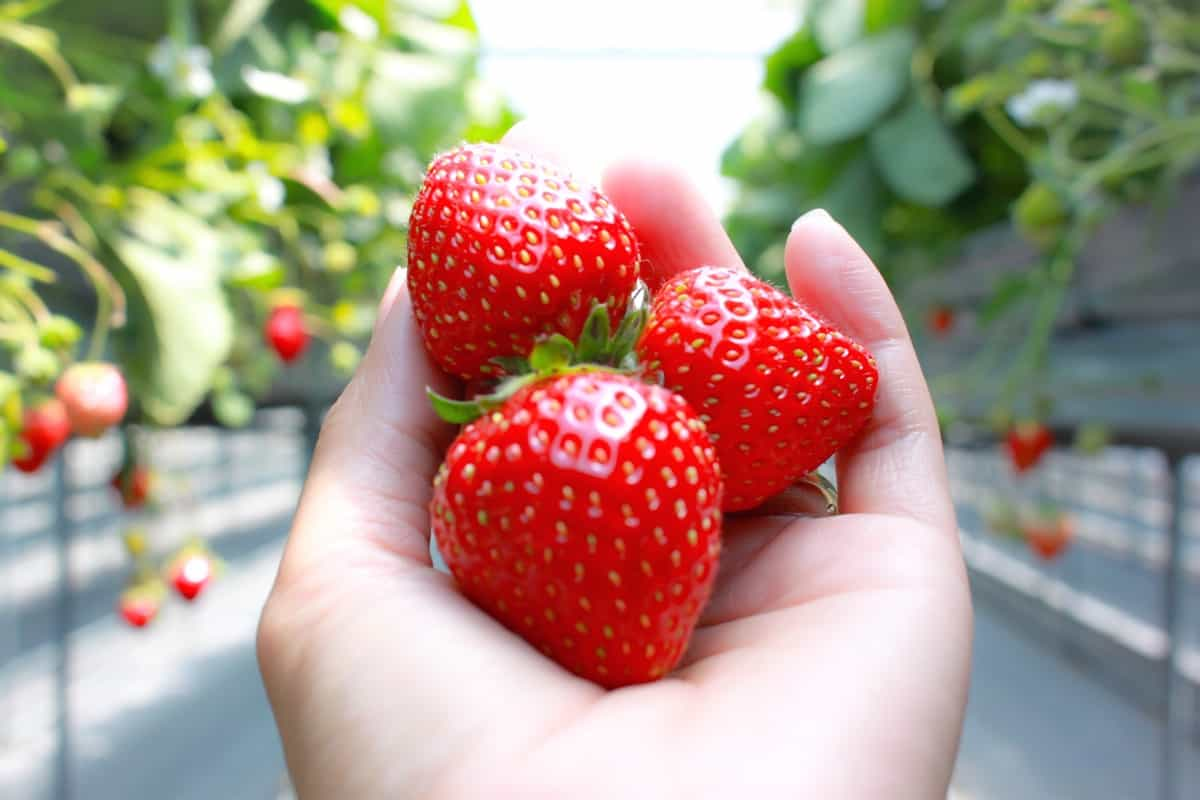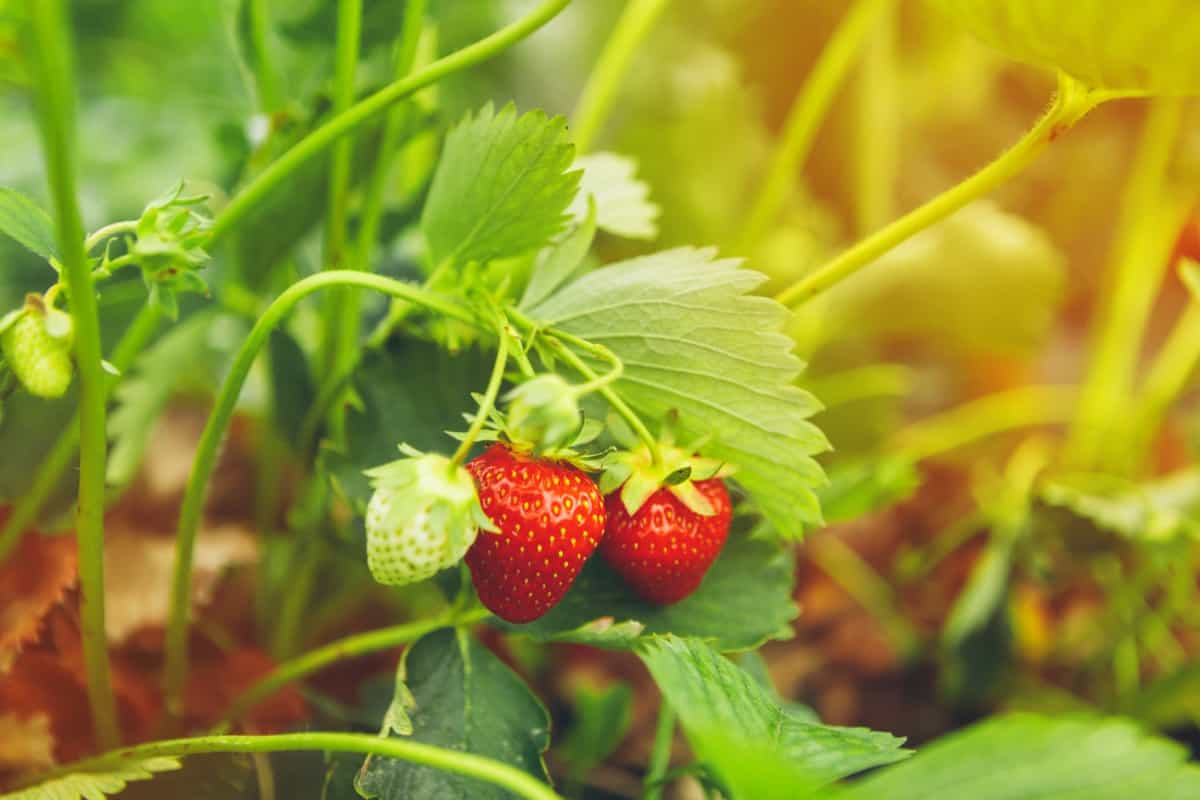While some challenges may be associated with growing Strawberries in a garden setting, armed with knowledge about disinfection techniques, fertilization strategies, watering guidelines, and pest and disease management practices, you can overcome these hurdles. With careful attention to detail and proactive care throughout the growing season, you’ll soon enjoy plump juicy berries straight from your backyard.

8 Common Problems with Garden-Grown Strawberries
How to Prevent Pests from Attacking Garden-Grown Strawberries
Pests can be a major nuisance when growing Strawberries in your garden. One of the simplest methods is to create physical barriers around your Strawberry plants. This could involve using row covers or netting to keep insects and birds at bay. Another option is companion planting, where you strategically plant other herbs or flowers that repel common Strawberry pests.
If you spot any bugs or larvae, remove them by hand or use an organic insecticidal soap spray as a gentle yet effective deterrent. Maintaining proper hygiene in your garden area is also key. Keep weeds under control, as they can attract pests and provide hiding places.
Common Diseases Affecting Strawberry Plants in Gardening
- Botrytis fruit rot
- Symptoms: This fungus thrives in cool, wet conditions and attacks ripe or overripe berries, causing them to turn brown and mushy.
- Control Measures: To prevent gray mold, make sure your plants have good air circulation by spacing them adequately apart.
- Powdery mildew
- Symptoms: This fungal infection appears as a white coating on the leaves and stems of the plant.
- Control Measures: To combat powdery mildew, use fungicides specifically formulated for Strawberries or promptly remove infected leaves.
- Leaf spot
- Symptoms: Caused by various fungi, leaf spot manifests as dark brown or black spots on the leaves. These spots can merge and cause defoliation if left untreated.
- Control Measures: Regularly inspect your plants for signs of leaf spot and remove infected foliage immediately.
- Root rot
- Symptoms: The roots become waterlogged and decay, leading to stunted growth or death of the plant itself.
- Control Measures: Ensure proper drainage in your garden beds by adding organic matter.
In case you missed it: Can Chickens Eat Oranges, Tomatoes, Grapes, Garlic, Banana Peels, Pineapple, Strawberries, Celery, and Asparagus?

Effective Methods for Controlling Weeds in Strawberry
One of the simplest ways to control weeds is through regular manual removal. Pulling up weeds by hand or using a small trowel can prevent them from taking root and spreading throughout your Strawberry patch. Mulching is another effective method for controlling weeds in Strawberry gardens. Applying organic mulch around the plants helps suppress weed growth by blocking sunlight and preventing their seeds from germinating.
Organic options such as straw or wood chips help retain soil moisture well. Consider using landscape fabric or plastic mulch for more stubborn or larger areas infested with weeds. These materials create an additional barrier between the soil surface and potential weed invaders while allowing water penetration. Regular cultivation is key to keeping your Strawberry patch free from unwanted vegetation.
How to Protect Strawberries from Frost Damage
When winter arrives, gardeners often face the challenge of protecting their Strawberry plants from frost damage. Freezing temperatures can cause significant harm to these delicate fruits, but with proper precautions, you can safeguard your harvest. One effective method is to cover your Strawberry plants with a straw or mulch layer. This insulation helps retain heat and prevents frost from settling on the leaves and berries.
Additionally, consider using frost blankets or row covers for added protection. Another way to protect Strawberries from frost is by watering them thoroughly before a freeze. Be sure to water in the early afternoon so that excess moisture has time to evaporate before nighttime temperatures drop. Try planting your Strawberries near structures like fences or walls that can provide some shelter against cold winds. These barriers help create slightly warmer microclimates than open areas, reducing the risk of frost damage.
Dealing with Nutrient Deficiencies in Garden-Grown Strawberries
Growing your Strawberries can be a rewarding experience, but sometimes these luscious fruits may face nutrient deficiencies that hinder their growth and productivity. One common nutrient deficiency in Strawberry plants is a lack of nitrogen. Nitrogen is crucial for promoting leafy growth and vibrant green foliage. To rectify this deficiency, you can apply organic fertilizers such as compost or well-rotted manure around the base of the plants.
Nitrogen-rich liquid foliar sprays can immediately boost the plants’ nutrient levels. Another vital nutrient for Strawberries is phosphorus, which aids root development and fruit production. If your plants exhibit stunted growth or have small fruits, it may indicate a phosphorus deficiency. To remedy this issue, consider adding bone meal or rock phosphate to the soil before planting.
These amendments slowly release phosphorus over time, ensuring continuous availability for the plants. Potassium is another essential nutrient Strawberries require for plant health and disease resistance. A potassium deficiency can manifest as weak stems or yellowing leaves with brown edges. Incorporating potash-rich fertilizers into your garden bed will help replenish potassium levels in the soil and promote robust plant growth.
Managing Fungal Infections in Strawberry Plants
First and foremost, it’s important to maintain good hygiene practices in your garden. Remove any dead or infected leaves and dispose of them properly. Avoid over-watering, as excess moisture can create the perfect breeding ground for fungi. Another strategy is to choose disease-resistant varieties when planting Strawberries.
In case you missed it: Red Leaves on Strawberry Plant: Causes, Remedies, and How to Fix It?

These varieties have been specially bred to withstand common fungal diseases, giving you an added layer of protection. Applying a fungicide may also be necessary if the infection persists or if you’re dealing with particularly aggressive strains of fungus. Follow the instructions carefully and apply at the recommended intervals for best results.
Consider providing adequate air circulation around your Strawberry plants to prevent fungal infections. This can be achieved by spacing them properly and pruning any overcrowded areas. Mulching with straw or pine needles can help keep soil-borne fungal spores from splashing onto plant leaves during watering or rainfall events.
Preventing Birds from Eating Straw-Eating Strawberries in The Garden
One effective way to deter birds is by using bird netting. This fine mesh netting creates a physical barrier around your plants, making it difficult for birds to access the berries. Simply drape the netting over your Strawberry plants and secure it tightly with stakes or clips. If you want a natural approach, consider planting companion plants that repel birds, such as marigolds or sunflowers.
These vibrant flowers add beauty to your garden and help keep unwanted avian guests at bay. Try setting bird feeders away from your Strawberry patch to divert their attention elsewhere. Providing an alternative food source for the birds may make them less inclined to snack on your precious berries.
Solutions for Strawberry Plants Flowering or Setting Fruits
When growing garden-fresh Strawberries, one of the most frustrating problems gardeners encounter is when their Strawberry plants fail to flower or set fruits. Make sure your Strawberry plants receive adequate sunlight. Strawberries thrive in full sun, so ensure they have at least six hours of direct sunlight each day. If nearby trees or structures shade your plants, consider relocating them to a sunnier spot in your garden.
Pay attention to proper watering techniques. Over-watering can lead to root rot and prevent flowering, while underwatering can cause stress and hinder fruit formation. Depending on rainfall, moisturize the soil by watering deeply once or twice a week. Provide nutrient-rich soil for your Strawberry plants. Inadequate nutrition can affect their ability to produce flowers and fruits.
Consider using organic fertilizers specifically formulated for Strawberries or enriching the soil with compost before planting. Additionally, take care of pollination needs. Strawberries rely on bees and other insects for pollination. If you notice a need for pollinators in your area, you may need to hand-pollinate the flowers using a small brush or cotton swab. Some varieties of Strawberries take longer than others to start flowering and setting fruits.
Give your plants time and continue providing optimal growing conditions until they begin producing those delicious berries you’ve been waiting for. Ensure adequate sunlight exposure, maintain proper watering practices, provide nutrient-rich soil through organic fertilizers or compost additions, promote natural pollination by attracting beneficial insects, and have patience, as some varieties may require more time before flowering begins.
In case you missed it: Hydroponic Strawberry Farming in a Greenhouse: Key Rules to Start from Scratch

Conclusion
While growing Strawberries in your garden comes with its fair share of challenges, proper care practices such as monitoring for pests/diseases regularly, addressing soil issues promptly, and providing adequate water supply with consistent watering techniques are key steps toward overcoming these obstacles.
- Feed Your Flock for Less: Top 10 Tips to Save on Chicken Feed
- Ultimate Guide to Ossabaw Island Hog: Breeding, Raising, Diet, and Care
- Hatching Answers: The Top 10 Reasons Your Chickens Aren’t Laying Eggs
- Eggs and Economics: Breaking Down the Cost of Raising Backyard Chickens
- Defend Your Greens: Proven Methods to Keep Iguanas Out of Your Garden
- Ultimate Guide to Cinnamon Queen Chicken: A Comprehensive Guide for Beginners
- Ultimate Guide to California Tan Chicken: Breeding, Raising, Diet, Egg-Production and Care
- Ultimate Guide to Marsh Daisy Chicken: Breeding, Raising, Diet, and Care
- 10 Types of Chicken Farming Businesses You Can Start for Profits